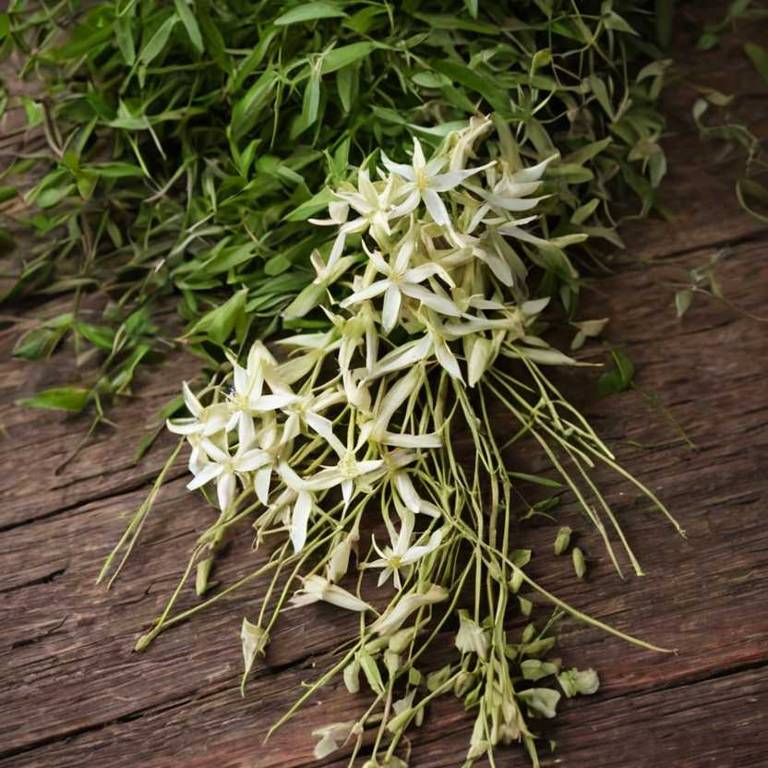By Leen Randell
Updated: Jul 06, 2024
What to know about Clematis armandii (chinese clematis) before using it medicinally

Clematis armandii, commonly known as Chinese Clematis, is a fragrant and versatile herb that offers numerous health benefits, from reducing inflammation and improving cardiovascular health to aiding in digestion and promoting relaxation.
As a horticultural asset, this evergreen climber is prized for its lush, dark green foliage and white, star-shaped flowers that bloom in late winter to early spring. Botanically, Clematis armandii belongs to the Ranunculaceae family and is native to China, where it has been used in traditional medicine for centuries.
Its historical significance can be traced back to ancient Chinese herbal remedies, where it was used to treat a range of ailments, including fever, coughs, and skin conditions.
This article explains the medicinal, horticultural, botanical, and historical aspects of Clematis armandii.
What are the medicinal properties of Clematis armandii?
Clematis armandii, also known as Chinese clematis, helps with respiratory issues, such as bronchitis and coughs, due to its anti-inflammatory and expectorant properties. It also soothes digestive problems, like diarrhea and nausea, and relieves pain and fever.
The active constituents of Clematis armandii include triterpenoid saponins, flavonoids, and alkaloids, which are responsible for its medicinal properties. These compounds have been shown to exhibit anti-inflammatory, antimicrobial, and antioxidant activities in vitro.
The roots and flowers of Clematis armandii are the most commonly used parts for medicinal purposes. The roots are rich in triterpenoid saponins, while the flowers contain flavonoids and alkaloids. These parts are often combined to create a synergistic effect.
Improper use of Clematis armandii can lead to side effects such as allergic reactions, stomach upset, and interactions with other medications. The plant's saponins can also cause kidney damage in high doses.
Precautions when using Clematis armandii medicinally include proper identification of the plant, proper dosage, and avoidance of interaction with other medications. Pregnant and breastfeeding women should also consult with a healthcare professional before using the plant.
What are the horticulural aspects of Clematis armandii?
Clematis armandii grow in USDA zones 6-9, requiring full sun to partial shade and well-drained, slightly acidic soil with a pH between 6.0-7.0. This evergreen vine thrives in a location with moderate to high humidity and temperatures between 35°F-90°F.
For optimal growth, plant Clematis armandii in the early spring or fall, choosing a location with a trellis or support to provide structural guidance. Plant the root system 2-3 inches above the ground, spreading the roots outward to prevent circling. Water well and mulch around the base to retain moisture.
Harvesting tips for Chinese Clematis include pruning after the blooming period in late spring or early summer. Remove any dead, diseased, or damaged stems and branches, cutting back the top growth by about one-third to one-half to maintain shape and promote new growth.
Pests and diseases affecting Chinese Clematis include scale, spider mites, and aphids, as well as fungal infections like petiole blight and leaf spot. Regularly inspect the plant for signs of infestation or disease, taking prompt action to treat any issues promptly to prevent further damage.
What are the botanical aspects of Clematis armandii?
Clematis armandii, also known as Chinese clematis, is an evergreen climber with twining stems and glossy, ovate to elliptic leaves, 10-20 cm long, arranged opposite, with 5-9 lobes. The plant can reach up to 6-8 meters in height, with a spread of 1-3 meters.
Taxonomically, Clematis armandii is classified in the family Ranunculaceae, order Ranunculales, with the following classification: Kingdom: Plantae, Phylum: Angiospermophyta, Class: Magnoliopsida, Order: Ranunculales, Family: Ranunculaceae, Genus: Clematis, and Species: C. armandii. This classification is based on morphological and molecular data.
The plant has several variants, including 'Apple Blossom', 'Carnaby', and 'Fortunei', which differ in leaf shape, flower color, and growth habit. Some cultivars are more compact or produce more flowers than others. These variants have been developed for their ornamental value and hardiness.
Clematis armandii is native to China, Japan, and Korea, where it grows in the mountains, in a temperate climate. It has been naturalized in the southern United States and parts of Europe, where it is often cultivated as an ornamental. It prefers well-drained soil and partial shade.
The life cycle of Clematis armandii is as follows: the plant grows from a perennial rootstock during the growing season, producing new leaves and stems. In late winter to early spring, the plant produces fragrant flowers, followed by fruit and seeds in late summer. After flowering, the plant begins to set seed, which is dispersed by wind and animals. The seedling then grows into a new plant, repeating the cycle.
What are the historical aspects of Clematis armandii?
Clematis armandii is a flowering evergreen vine with a rich history of cultivation and use. In ancient China, the plant was valued for its fragrant flowers and used in perfumes, incense, and medicinal preparations.
In Chinese mythology, the Clematis armandii was associated with the goddess of silk, Weaving Maiden, who was said to have used its flowers to adorn her robes. The plant was also linked to the Eight Trigrams of the I Ching, representing balance and harmony.
Throughout history, the Clematis armandii has been imbued with symbolic meanings, including good fortune, longevity, and fertility. In traditional Chinese wedding ceremonies, the plant's fragrant flowers were used to ward off evil spirits and attract good luck.
In historical texts, the Clematis armandii is mentioned in the 17th-century Chinese botanical work, "Ben Cao Gang Mu" by Li Shizhen. The text describes the plant's properties, uses, and cultivation methods, highlighting its value in traditional Chinese medicine.
Archaeological discoveries have revealed the presence of Clematis armandii flowers in ancient Chinese tombs, suggesting their significance in funerary rituals and burial practices. The plant's image has also been depicted in Chinese art and ceramics from various dynasties, underscoring its enduring cultural relevance.